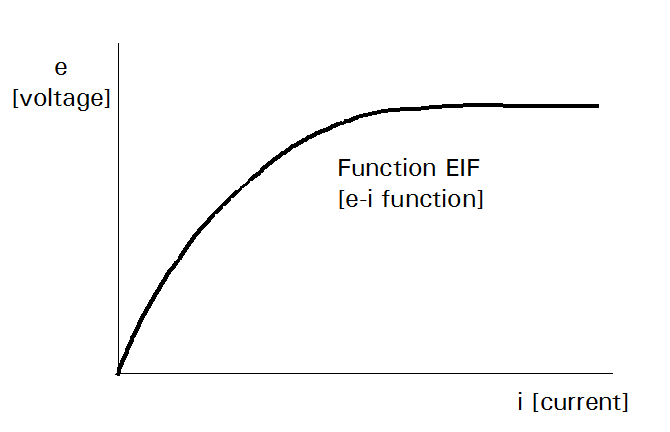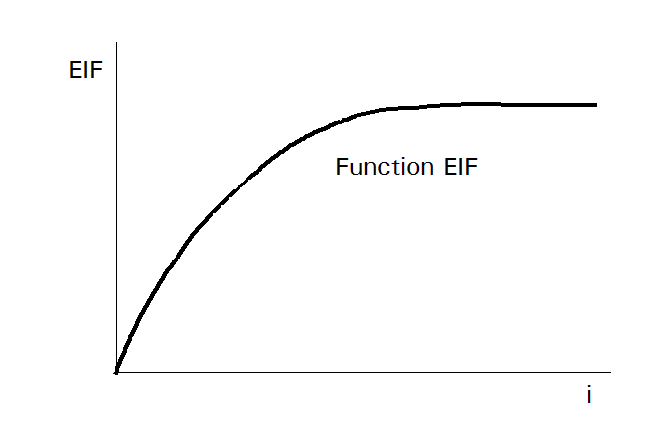Doug Kerr
Well-known member
In mathematics, a function is said to exist when the value of one variable depends (in a predictable way) on the value of another variable.
Although we rarely say it, the circumference of a circle is a function of the diameter.
But there are some customs that can actually make it difficult to clearly describe some things in the world of functions.
In the realm of electronic components, we find that the voltage across a certain diode (e) is a function of the current through it (i). We can speak of the specific relationship as as the e-i function of the diode. Suppose that for the benefit of the mathematicians the function is given the name "EIF".
We can present the function graphically like this:

The x-axis representes the current through the diode, i. The y-axis represents the voltage across the diode, e.
And here we have labeled the two axes accordingly (with explanations of the variables in brackets).
But in fact, at some particular current, the voltage can also be described as "the value of EIF" at that current.
But once we have done that, a next step is to label the y-axis "EIF", as we see here:

How do we know that this really means "voltage"? We just have to know. If somebody says "EIF", does that mean the function or the voltage the function prescribes for different currents? We just have to be careful
Now, a next step is for the mathematician to ask, for example, "at that time, what is the EIF?. The question of course means, "at that time, what is the voltage across the diode". And of course an electrical engineer would ask it that way. But the mathematician is proud that he knows the "jargon" of the world of functions.
************
In photography, we are interested in the relative "response" of the optical system to components in the variation of luminance of the object at different spatial frequencies. We speak of the degree of variation of luminance, by which detail is portrayed, as the "depth of modulation" of the luminance (a term borrowed from electrical engineering, when it means the change in, for example, a voltage to convey some information).
We are interested in, for any given spatial frequency of variation in luminance, how the depth of modulation in the actual object is preserved in the image. Ideally, whatever the depth of modulation is in the object, the same would be carried to the image.
But in fact the realities of actual lenses are such that generally the depth of modulation presented to the image is less than the depth of modulation at the object. And in fact, in general, the degree of this "loss of depth of modulation" is greater as the spatial frequency increases.
Now we can quantify this loss of depth of modulation by a ratio I will call the "modulation transfer ratio". It is just the ratio, for any small area of the object, the ratio of (a) the depth of modulation presented to the image to (b) the depth of modulation at the object.
Now, how do we label the two axes of this plot, and how do we speak of the two variables it relates?
Well, we label the x-axis as "spatial frequency" (various symbols are used for that).
And, just like the mathematician in the story about the e-i function of a diode, we label the y-axis (which presents the modulation transfer ratio) as "MTF".
But I thought "MTF" was the name for the variation of the modulation transfer ratio with spatial frequency. Well, it is.
But, following the mathematical custom I described earlier, we say that the y-value is "the value of the function MTF for each spatial frequency", which then degrades to "the MTF for each spatial frequency".
And so we label the y-axis of the plot of the function MTF as "MTF".
And of course this leads to such conversations as this:
"So, then what is the MTF at a frequency of 15 cycles/mm"?
"Well, the whole MTF for that lens is shown by the curve."
"Well yes, but I mean is what is the MTF at a frequency of 15 cycles/mm?"
"Oh, for that lens' MTF, that MTF is about 45%."
You can see why I hate this custom (even though I well understand the mathematical rationale behind it).
In any case, in general, to avoid this ambiguity, in the matter of modulation transfer functions, I refer to the modulation transfer ratio (the quantity of the y-axis) as the "modulation transfer ratio."
Best regards,
Doug
Although we rarely say it, the circumference of a circle is a function of the diameter.
But there are some customs that can actually make it difficult to clearly describe some things in the world of functions.
In the realm of electronic components, we find that the voltage across a certain diode (e) is a function of the current through it (i). We can speak of the specific relationship as as the e-i function of the diode. Suppose that for the benefit of the mathematicians the function is given the name "EIF".
We can present the function graphically like this:

The x-axis representes the current through the diode, i. The y-axis represents the voltage across the diode, e.
And here we have labeled the two axes accordingly (with explanations of the variables in brackets).
But in fact, at some particular current, the voltage can also be described as "the value of EIF" at that current.
But once we have done that, a next step is to label the y-axis "EIF", as we see here:

How do we know that this really means "voltage"? We just have to know. If somebody says "EIF", does that mean the function or the voltage the function prescribes for different currents? We just have to be careful
Now, a next step is for the mathematician to ask, for example, "at that time, what is the EIF?. The question of course means, "at that time, what is the voltage across the diode". And of course an electrical engineer would ask it that way. But the mathematician is proud that he knows the "jargon" of the world of functions.
************
In photography, we are interested in the relative "response" of the optical system to components in the variation of luminance of the object at different spatial frequencies. We speak of the degree of variation of luminance, by which detail is portrayed, as the "depth of modulation" of the luminance (a term borrowed from electrical engineering, when it means the change in, for example, a voltage to convey some information).
We are interested in, for any given spatial frequency of variation in luminance, how the depth of modulation in the actual object is preserved in the image. Ideally, whatever the depth of modulation is in the object, the same would be carried to the image.
But in fact the realities of actual lenses are such that generally the depth of modulation presented to the image is less than the depth of modulation at the object. And in fact, in general, the degree of this "loss of depth of modulation" is greater as the spatial frequency increases.
Now we can quantify this loss of depth of modulation by a ratio I will call the "modulation transfer ratio". It is just the ratio, for any small area of the object, the ratio of (a) the depth of modulation presented to the image to (b) the depth of modulation at the object.
You have probably never seen the term "modulation transfer ratio" except in my writings. Stay tuned to find out why.
If we plot this ratio against spatial frequency, we get a curve we says portrays the "modulation transfer function" (MTF), our optical "spatial frequency response function".Now, how do we label the two axes of this plot, and how do we speak of the two variables it relates?
Well, we label the x-axis as "spatial frequency" (various symbols are used for that).
And, just like the mathematician in the story about the e-i function of a diode, we label the y-axis (which presents the modulation transfer ratio) as "MTF".
But I thought "MTF" was the name for the variation of the modulation transfer ratio with spatial frequency. Well, it is.
But, following the mathematical custom I described earlier, we say that the y-value is "the value of the function MTF for each spatial frequency", which then degrades to "the MTF for each spatial frequency".
And so we label the y-axis of the plot of the function MTF as "MTF".
And of course this leads to such conversations as this:
"So, then what is the MTF at a frequency of 15 cycles/mm"?
"Well, the whole MTF for that lens is shown by the curve."
"Well yes, but I mean is what is the MTF at a frequency of 15 cycles/mm?"
"Oh, for that lens' MTF, that MTF is about 45%."
You can see why I hate this custom (even though I well understand the mathematical rationale behind it).
In any case, in general, to avoid this ambiguity, in the matter of modulation transfer functions, I refer to the modulation transfer ratio (the quantity of the y-axis) as the "modulation transfer ratio."
Best regards,
Doug
